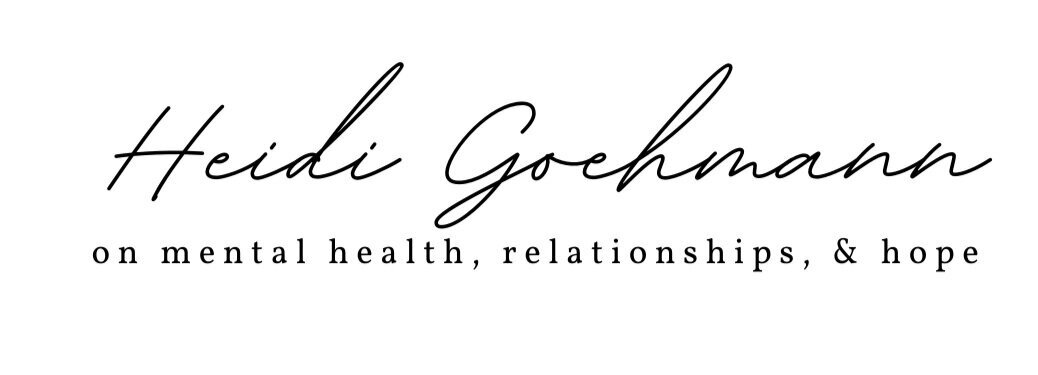The Many Layers of Anxiety
When I was a little kid, everything seemed large…
the trees outside my window at night
the strangers buzzing all around me in the store
the shower head and its torrential downpour
the language of adults floating down to my ears wherever we went
I can see myself sitting cross-legged in front of the tv, soaking in the words of Big Bird or Mr. Rogers…
“Of course the world feels big when you are small!”
“Of course you have questions!”
“Of course you need a hug, to be held, to be warm and safe and less frightened.”
Of course goes a long way when anxiety presses in on little lives. Of course also goes a long way for our own adult experiences of anxiety. Of course helps connect the care we have received in other moments of challenge or fear in life - our youngest parts, our teenage selves, our young adult selves, and more - to give remembrance of that care to the anxiety we are experiencing in the moment. If our bodies are going to remember our anxiety across the lifespan, of course helps them remember the kindnesses attached to that anxiety also. Of course is a vestige of long-ago friends reaching through the tv screen, a caregiver’s warmth when we feel uncertain, the hand of an incarnate Savior reaching into our life rather than backing away from it.
Anxiety is a messy emotion. Anxiety contains layer upon layer of biochemical, emotional, cognitive, and yes, spiritual undertones. Western culture often likes to oversimplify anxiety - “think differently, courage over fear, seize the day, believe in yourself!” All well-meaning messages that whitewash a complex emotion full of the baggage of the past and the brokenness of our present reality.
Anxiety:
an internal biological response, both conscious and sub- or un- conscious, related to present events and past experiences, often including great discomfort
Anxiety is not fear or worry, although there is a strong relationship within this triangle of emotions. The distinctions are important. While all emotions have physical and biochemical components - fear, often the rush of hormones to save us from perceived danger; worry, a neurological construct aimed toward safety through thinking and more thinking - anxiety’s underpinnings represent an overcrowding of chemicals within our systems over time. Anxiety is made of building blocks, often constructed when we were small, outside of awareness and answers to our fears. The biochemical reactivity of our own body to a broken world is malleable, but also in many ways outside our control. Our hearts shudder to discover that the world is unsafe at times, the protection of our caregivers limited by their own humanness, the protection of God outside our sightline.
Once the chemicals get going, by our very human and reasonably misshapen understanding, or by the brokenness of DNA and cells gone awry, the structure of our anxiety can be so strong that it is hard to imagine any wrecking ball or jackhammer large enough to break through towards rebuilding. Besides, who wants to undertake wrecking and rebuilding if the wrecking and rebuilding is what is necessary for restoration? Healing in itself, particularly when faced with each day’s new brokenness, feels daunting.
Because anxiety is often so far outside of our control, I want you to hear this first:
You, dear reader, are not your anxiety.
God sees you apart from your anxiety. It is not always related to distrust or doubt or lack of courage. Your psyche has a whole inner world with layers upon layers of ways the system gets elevated. Anxiety may be part of your life, even a big part, but it is not you. It is the cost of brokenness inside of you. We heal through a compassionate response to our anxious internal voices, by listening and loving even these challenging parts of ourselves, as God does, saving us as whole people, not in part.
Start peeling back anxiety layer by layer with this phrase:
“Hi, Anxiety. I hear you. I see you. We are not alone. God is in this too.”
Compassion begins to shift the building blocks of anxiety, so that a new structure can be formed internally. There are layers of work to do - psychological and physical healing are both part of the toil promised in Genesis 3 as a result of brokenness. But the same God who says “do not be anxious, do not be afraid” is the One reaching in guiding the shift of all our parts and chemicals and thoughts and experiences toward wholeness and healing. Christ will not leave us on our own.
Can you see the layers to anxiety? the complexity? the many parts still covered in God’s grace and friendship?
This is the beginning of healing - allowing ourselves room for complexity, sitting next to our anxiety and peeling back one layer at a time, learning about ourselves, about the brokenness of the world, and about a God who has made space for all of it alongside us.
What anxious part of you needs to hear “of course!”? Because the reality of the pain in the world needing God’s restoration makes total sense, even found within ourselves.
Of course we would be anxious.
Of course our hormones and neuropathways would be impacted by all the challenges we’ve witnessed around us.
Of course we are just young ones, living in a too-big world, trying still at age 20, 40, 60, 80 to grow into ourselves enough to understand it all.
Of course God invites us to be tended to, to sort, and to heal.
The many layers of anxiety - never outside of God’s care.
Read and listen to more layers of anxiety, its makeup, its theology, and tools toward healing in our podcast episodes about fear, worry, and anxiety below.

